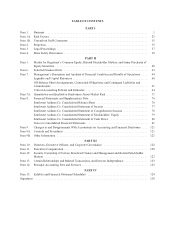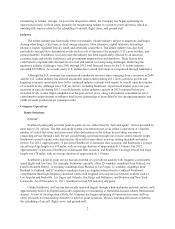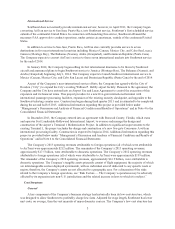Southwest Airlines 2013 Annual Report Download - page 16
Download and view the complete annual report
Please find page 16 of the 2013 Southwest Airlines annual report below. You can navigate through the pages in the report by either clicking on the pages listed below, or by using the keyword search tool below to find specific information within the annual report.used 737 aircraft from other sources. Transitioning the Boeing 717 fleet to Delta avoids added complexity to the
Company’s operations, as the Company has historically operated an all-Boeing 737 fleet. Replacement of the
Boeing 717 aircraft capacity with Boeing 737 capacity provides revenue opportunities with more seats per
aircraft, while costing approximately the same amount to fly on a per-trip basis as the smaller Boeing 717
aircraft.
Continued Incorporation of the Larger Boeing 737-800 into the Southwest Fleet
To further support its fleet modernization efforts, during 2013, the Company continued to incorporate the
Boeing 737-800 into the Southwest fleet. The 737-800’s all coach seating configuration of 175 offers
significantly more Customer seating capacity than Southwest’s other aircraft. In addition to the 737-800’s added
seating capacity, its configuration includes The Boeing Company’s Sky Interior, which features a quieter cabin,
improved operational security features, and LED reading and ceiling lighting. In addition, the domestic airline
industry has experienced a decline in shorthaul flying since 2000, and the 737-800 allows the Company to adjust
its route network to allow for more longhaul flying. The Company expects the 737-800 will continue to enable it
to (i) more economically serve longhaul routes; (ii) improve scheduling flexibility and more economically serve
high-demand, slot-controlled, and gate-restricted airports by adding seats to such markets without increasing the
number of flights; and (iii) boost fuel efficiency to reduce overall unit costs. Additionally, the Company expects
the 737-800 will enable Southwest to profitably expand to new destinations, including extended routes over
water, and potentially fly to more distant markets such as Hawaii, Alaska, Canada, Mexico, the Caribbean, and
other near-international locations. The Company has taken delivery of 52 Boeing 737-800 aircraft from 2012
through 2013 and currently expects to take delivery of an additional 33 and 19 Boeing 737-800s during 2014 and
2015, respectively. The Company’s fleet composition and delivery schedule is discussed in more detail below
under “Properties — Aircraft.”
International Capabilities and New Reservation System
In January 2014, the Company launched an international reservation system and began selling its inaugural
international daily nonstop service to be flown by Southwest aircraft beginning July 1, 2014, to Jamaica
(Montego Bay), The Bahamas (Nassau), and Aruba (Oranjestad). In this first phase of the Company’s
international conversion plan, AirTran will continue service between Atlanta and Nassau and between Chicago
Midway and Montego Bay, as well as flights to/from Cancun, Mexico City, and Cabo San Lucas, Mexico, and
Punta Cana, Dominican Republic. The Company expects to complete the launch of Southwest service to Mexico
(Cancun, Mexico City, and Cabo San Lucas) and Dominican Republic (Punta Cana), AirTran’s remaining four
international destinations, by the end of 2014. The Company worked with Amadeus IT Group to implement
Amadeus’ Altea reservations solution to support the Company’s international service.
The Company also intends to replace Southwest’s existing domestic reservation system with a
comprehensive system that would provide Southwest with the ability to serve both domestic and international
markets. The Company is currently in the planning stages of this multi-year project, and intends to select the
vendor in the first half of 2014.
Continued Growth of Southwest’s Rapid Rewards Frequent Flyer Program
In March 2011, Southwest launched its current Rapid Rewards frequent flyer program, under which
members earn points for every dollar spent. The amount of points earned under the program is based on the fare
and fare class purchased, with higher fare products (e.g., Business Select) earning more points than lower fare
products (e.g., Wanna Get Away). Each fare class is associated with a points earning multiplier, and points for
flights are calculated by multiplying the fare for the flight by the fare class multiplier. Likewise, the amount of
points required to be redeemed for a flight is based on the fare and fare class purchased. Under the program
(i) members are able to redeem their points for every available seat, every day, on every flight, with no blackout
dates; and (ii) points do not expire so long as the Rapid Rewards Member has points-earning activity during the
most recent 24 months.
8
























